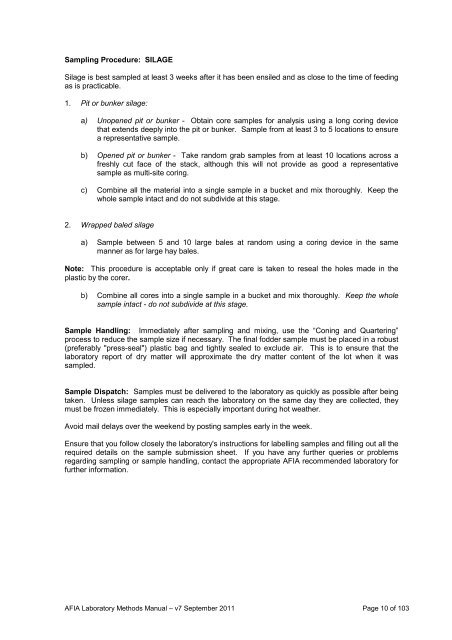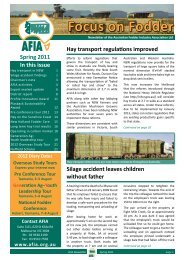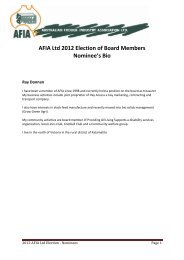AFIA - Laboratory Methods Manual - Australian Fodder Industry ...
AFIA - Laboratory Methods Manual - Australian Fodder Industry ...
AFIA - Laboratory Methods Manual - Australian Fodder Industry ...
Create successful ePaper yourself
Turn your PDF publications into a flip-book with our unique Google optimized e-Paper software.
Sampling Procedure: SILAGE<br />
Silage is best sampled at least 3 weeks after it has been ensiled and as close to the time of feeding<br />
as is practicable.<br />
1. Pit or bunker silage:<br />
a) Unopened pit or bunker - Obtain core samples for analysis using a long coring device<br />
that extends deeply into the pit or bunker. Sample from at least 3 to 5 locations to ensure<br />
a representative sample.<br />
b) Opened pit or bunker - Take random grab samples from at least 10 locations across a<br />
freshly cut face of the stack, although this will not provide as good a representative<br />
sample as multi-site coring.<br />
c) Combine all the material into a single sample in a bucket and mix thoroughly. Keep the<br />
whole sample intact and do not subdivide at this stage.<br />
2. Wrapped baled silage<br />
a) Sample between 5 and 10 large bales at random using a coring device in the same<br />
manner as for large hay bales.<br />
Note: This procedure is acceptable only if great care is taken to reseal the holes made in the<br />
plastic by the corer.<br />
b) Combine all cores into a single sample in a bucket and mix thoroughly. Keep the whole<br />
sample intact - do not subdivide at this stage.<br />
Sample Handling: Immediately after sampling and mixing, use the “Coning and Quartering”<br />
process to reduce the sample size if necessary. The final fodder sample must be placed in a robust<br />
(preferably "press-seal") plastic bag and tightly sealed to exclude air. This is to ensure that the<br />
laboratory report of dry matter will approximate the dry matter content of the lot when it was<br />
sampled.<br />
Sample Dispatch: Samples must be delivered to the laboratory as quickly as possible after being<br />
taken. Unless silage samples can reach the laboratory on the same day they are collected, they<br />
must be frozen immediately. This is especially important during hot weather.<br />
Avoid mail delays over the weekend by posting samples early in the week.<br />
Ensure that you follow closely the laboratory's instructions for labelling samples and filling out all the<br />
required details on the sample submission sheet. If you have any further queries or problems<br />
regarding sampling or sample handling, contact the appropriate <strong>AFIA</strong> recommended laboratory for<br />
further information.<br />
<strong>AFIA</strong> <strong>Laboratory</strong> <strong>Methods</strong> <strong>Manual</strong> – v7 September 2011 Page 10 of 103







